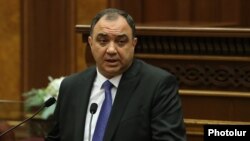According to the Armenian police, 82 people died in various road accidents there, sharply up from 53 in 2022. The total number of all accidents similarly rose from 1,990 to 1,797.
“There are no potholes, and so people are speeding,” Ghazarian told Armenian lawmakers when he was asked to explain a continuing worsening of Yerevan’s road safety indicators. He said that the police have “analyzed them a lot.”
Ghazarian’s claim about the state of the city’s roads contrasts with widespread anecdotal evidence to the contrary. Many of those roads are now dotted with many potholes not seen for years. An RFE/RL reporter counted more than three dozen of them during a 10-minute car ride through the Armenian capital.
“Things are getting worse,” said one car driver. “They look like trenches, not potholes.”
The municipal authorities say this is the inevitable result of winter snowfall and chemicals used for clearing snow and ice from the streets. They have pledged to start large-scale road repairs on Wednesday. The past winter was unusually warm in Armenia.
The growing number of road fatalities in Yerevan mirrors a nationwide trend. The police data shows that vehicle accidents killed 378 people across the country last year, up from 321 deaths recorded in 2022. The total number of accidents rose by 7 percent to 4,613.
The annual traffic deaths kept growing amid a continued expansion of Armenia’s new, Western-funded road police. The Patrol Service was set up in 2021 and expanded to all regions of the country by 2023 with financial and technical assistance provided by the United States and the European Union. It was meant to introduce Western standards in road policing, street patrol and crowd control.
Critics regularly accuse newly trained officers of the Patrol Service of incompetence. The first chief of the Patrol Service, Artur Umrshatian, was sacked in February 2023 after his subordinates took more than 20 minutes to stop a car racing chaotically through Yerevan’s main square.
Lenient and inconsistent road policing seems to be another factor. This may explain why most Armenian motorists have stopped fastening their seat belts over the past few years. Few of them are fined for such violations.
Nevertheless, Prime Minister Nikol Pashinian and other officials regularly portray the Patrol Service as a successful example of police reforms carried out by the current Armenian government.
During the 2018 “velvet revolution” that brought him to power, Pashinian repeatedly lambasted Armenia’s former government for aggressively enforcing traffic rules with fines. His government forgave thousands of car owners that had refused to pay such fines and also reduced most of the legal penalties for traffic violations. But it toughened some of them after traffic deaths surged from 279 in 2017 to 343 in 2018.







